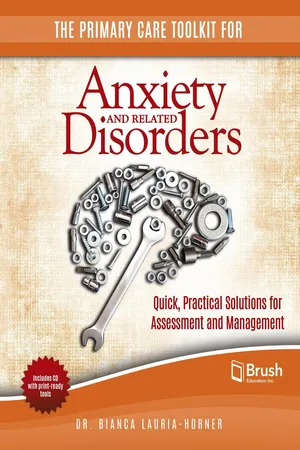
- 256 pages
- English
- ePUB (mobile friendly)
- Available on iOS & Android
The Primary Care Toolkit for Anxiety and Related Disorders
About this book
Primary care physicians know from experience how many patients come to them needing help with anxiety and related disorders: these disorders have a lifetime prevalence rate of 30%, but they often seem to be present in a much higher proportion of primary care visits.
Time pressure challenges every primary care provider who responds to these disorders. The Primary Care Toolkit for Anxiety and Related Disorders —carefully aligned with the DSM-5—gives you the tools to help you treat your patients promptly and effectively.
Quickly find the information and strategies you need using summaries of diagnostic criteria and pharmacological therapies, severity assessments, treatment summaries, and case studies. Efficiently screen, diagnose, and manage common anxiety and related disorders, using visit-by-visit guides for mild, moderate, and severe disorders.
An accompanying CD puts the best, most effective diagnostic tools at your fingertips, ready to be printed and used by you and your patients: patient self-report forms and questionnaires, symptom checklists, functional impairment assessment scales, and more.
The Primary Care Toolkit helps prepare you for the 7 anxiety and related disorders that primary care physicians see most often:
- Generalized anxiety disorder,
- Panic disorder,
- Agoraphobia,
- Social anxiety disorder,
- Obsessive-compulsive disorder,
- Posttraumatic stress disorder,
- Adjustment disorder.
Whether you are a family physician, an ER doctor, a pharmacist, a nurse or nurse practitioner, or a medical student, the information and resources in The Primary Care Toolkit for Anxiety and Related Disorders will add to your clinical primary care knowledge and skills.
Frequently asked questions
- Essential is ideal for learners and professionals who enjoy exploring a wide range of subjects. Access the Essential Library with 800,000+ trusted titles and best-sellers across business, personal growth, and the humanities. Includes unlimited reading time and Standard Read Aloud voice.
- Complete: Perfect for advanced learners and researchers needing full, unrestricted access. Unlock 1.4M+ books across hundreds of subjects, including academic and specialized titles. The Complete Plan also includes advanced features like Premium Read Aloud and Research Assistant.
Please note we cannot support devices running on iOS 13 and Android 7 or earlier. Learn more about using the app.
Information
SECTION II
Anxiety Disorders
4
Generalized Anxiety Disorder
Introduction
Clinical Presentation
Prevalence
Generalized Anxiety Disorder Case Study: Meet Mr. AG
ASSESSMENT: SCREENING AND PROVISIONAL DIAGNOSIS
Table of contents
- Cover
- Title Page
- Contents
- Toolkit Overview
- Tools for Primary Care Practice
- Practice Case Study Index
- SECTION I: Anxiety and Related Disorders
- SECTION II: Anxiety Disorders
- SECTION III: Obsessive-Compulsive and Related Disorders
- SECTION IV: Trauma- and Stressor-Related Disorders
- Appendices
- Additional Resources
- About the Author